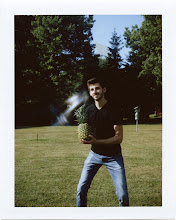I ended up looking through the different parts, in order to try to find a matching set that might easily fit together as a camera. I was hoping for 8x10 parts, but instead settled on a back that would fit an 8x10 camera, but was setup for 5x7 film holders. I figured that I could always start small and if I decided 8x10 made sense some time in the future, all it would take is a different back, rather than a different camera. The jump from 4x5 to 5x7 isn't that great, but it does offer a bit of size, and it would make sense to mess around with a workflow for glass plates with the smaller size and then move up to 8x10 once I had a real system in place (more on glass plates in the future).

The set of bellows seemed to be from an old 8x10 camera, as the opening at the rear was much too large for 5x7 and not quite large enough for 11x14. They hadn't been used in a really long time and were a bit stuck together. I asked Tim to hold on end and I would extend the other to make sure they could still easily expand and contract. As I started stretching them, the woman running the sale gave me a terrified look as if she was afraid that they would be ruined. I told her I would be buying them either way (even if the bellows weren't usable, the front and rear elements would be good to use in any camera I could build). She seemed relieved and I stretched them the rest of the way with no trouble. The outside corners do show a bit of wear, but they are light-tight and must be double lined because the inner structure looks perfect.

On one table in the middle there were a bunch of lenses. I looked through them and chose the one that I thought would fit my project the best. It is a Kodak No 36 Anastigmat 12 inch lens. It has stops all the way from 4.5 to 45 so it would be fast enough for wet plate (debatable) but could be stopped down for landscape work with film. The lens board ended up getting chipped on my flight back home from Minneapolis, but it isn't the right size anyway so I am going to be building a new one to put the lens in. I almost regret not buying a few more of the lenses that the lady had (I can't remember exactly what they were), especially since I didn't know a great deal about large format lenses back then, and some of them might be more useful.
Jump forward almost a year, and I'm finally getting around to actually making something from those parts. I picked out some Cherry wood to use as the frame, and I found a local place where I can get brass for the finishings. The only items I have left to get are the hardware (screws, nuts, etc) and the rack, gears, and knobs. I'm going to build the basic structure and then order those parts when I know exactly what I'm looking for. I'll be borrowing most of my design from field cameras, while incorporating as many movements as I can. The front rack is going to fold up to lock and hold everything in place. When folded down, it will provide enough extension to allow for focus at infinity and (if everything goes as plan) close-up portraits. I don't have a lot of bellows to work with, so it might not provide for as much portrait work as I might like - we'll see.
My design is mostly drawn out and I will begin working on some scrap wood soon to get a hang of the saws and particular cuts I'll be making. Cherry is too expensive to jump right in and screw up. I'm keeping track of everything that I spend money on for this camera, so I should be able to provide a simple list of how much it could cost to build your own 5x7/8x10 camera. My goal is to keep it under $250, so we'll see how that goes. If I wanted to spend more, I would have just gone to a local antique store and bought the 8x10 that they have sitting behind the counter; I've seen it there for over 20 months, so it doesn't seem like anyone else wants it.
I know I'm getting a bit ahead of myself, but if all goes as planned, I might be able to turn this woodworking/building into some sort of business and I can spend less time sitting behind a desk and more time enjoying something I love. I'll take it all in stride though.
Any thoughts, comments, or suggestions, feel free to share!

all of it sounds very exciting! looking forward to see ready to go camera. good luck!
ReplyDeleteThis project sounds exciting, I can not wait to see your results
ReplyDelete